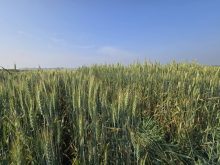Warm, late-summer weather has Canadian farmers reaping bigger and better harvests than they expected in midsummer, when slow growth and bad weather suggested a potential crop disaster.
Farmers now look to escape a year of drought, flooding and cool temperatures across the Prairies with slightly below-average-size crops of wheat and barley and average quality, said Bruce Burnett, Canadian Wheat Board director of weather and market analysis, Sept. 16.
Warm weather has accelerated crop maturity to the point that, even if there were frost this week, plants would be strong enough that kernel damage would be minimal, Burnett said.
Read Also

Still hard to predict precise fertilizer payback
Despite decades of advances, international research finds no clear answer for where and when adding nutrient will fail to boost growth.
At midsummer, prior to warmer weather settling in, the CWB had expected widespread frost at the usual time in the first week of September to inflict major crop damage.
Burnett said Canada’s all-wheat crop will likely grow one million to two million tonnes from the most recent estimate of 22.5 million tonnes by the USDA, but short of the five-year average of 25.3 million tonnes.
The barley crop is likely to exceed StatsCan’s Aug. 21 estimate of 8.9 million tonnes by 200,000 to 500,000 tonnes, Burnett said.
Quality of the wheat and barley crops are likely to be average, with the CWB now expecting only five to 10 per cent of the wheat crop to fall to feed quality (compared with its estimate of 13 to 15 per cent on July 30).
The canola crop, which Canada’s Agriculture Department estimated at 9.5 million tonnes on Aug. 28, could grow to between 10 million and 11 million tonnes thanks to the heat, said John Mayko, senior agronomy specialist for the Canola Council of Canada.














